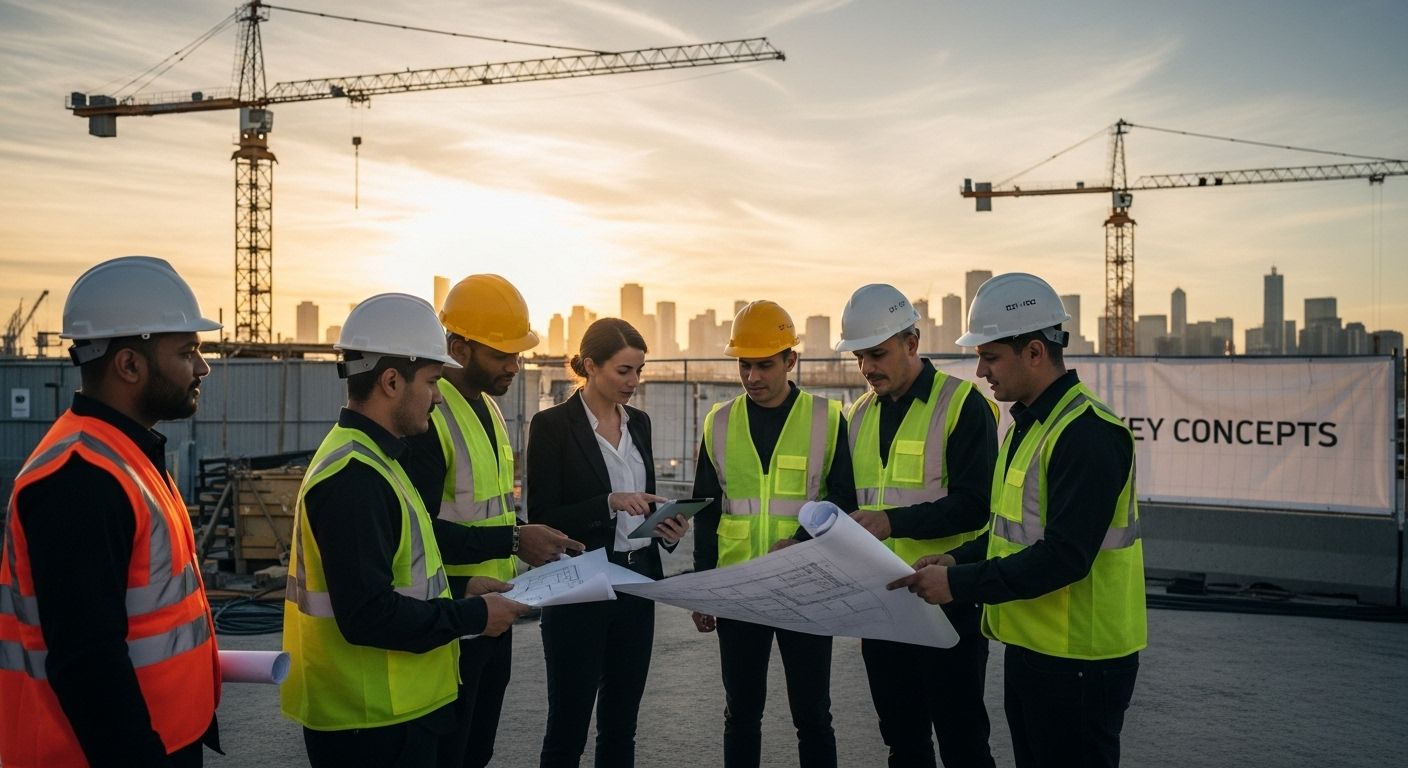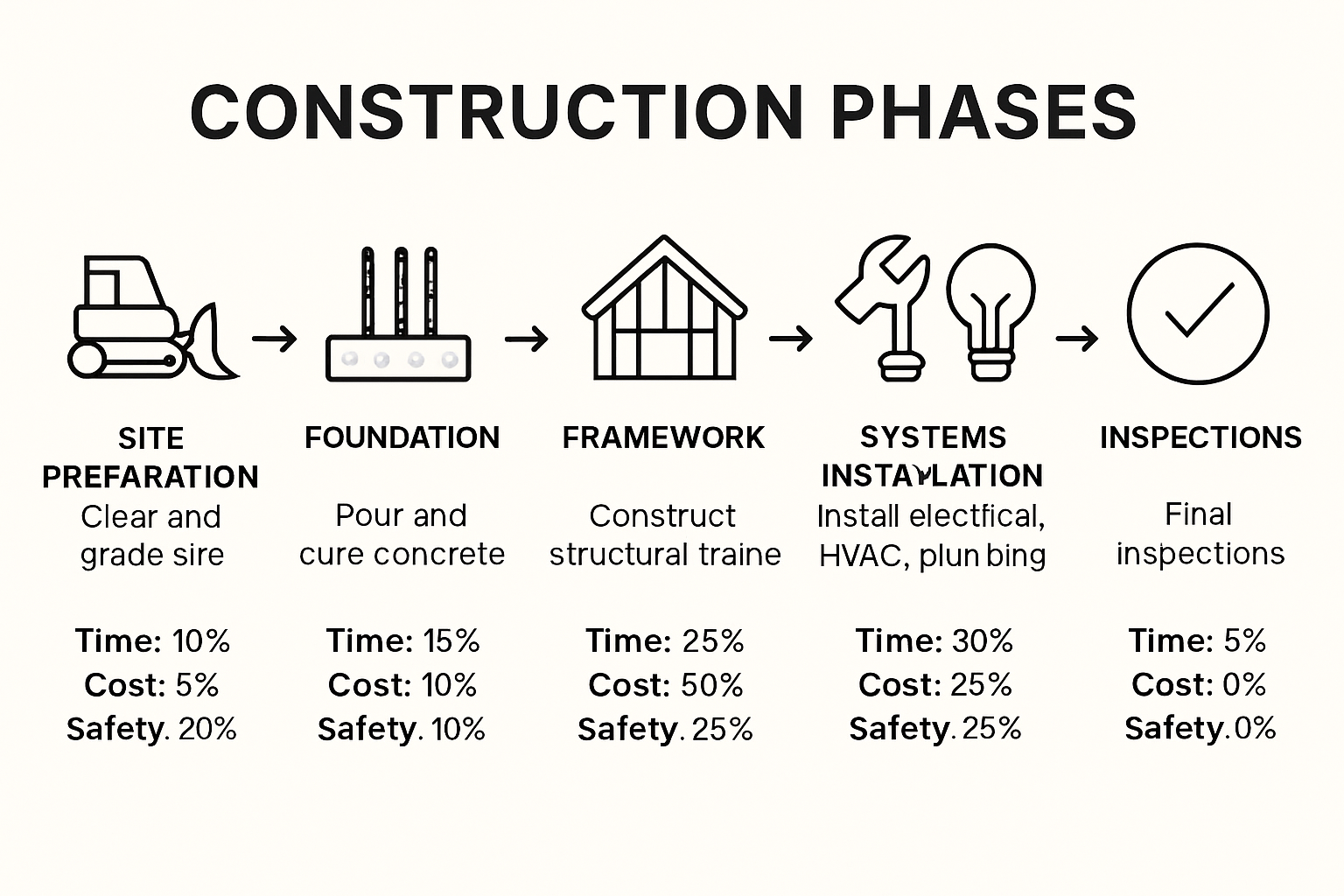Construction powers nearly everything we depend on, from sleek city skyscrapers to the networks of roads connecting entire regions.

Yet despite how visible these projects are, the true scale of construction’s impact often goes unnoticed. The industry employs over 7 million people in the United States alone and is responsible for shaping the very fabric of our society. But while most people picture cranes and concrete, what truly sets this field apart is not just what gets built, but how evolving technology, materials, and expertise are redefining the future before our eyes.
Table of Contents
- What Is Construction And Its Importance?
- The Key Components Of Construction Projects
- Understanding Construction Materials And Their Use
- The Role Of Safety In Construction Practices
- How Technology Is Transforming Construction Today
Quick Summary
| Takeaway | Explanation |
|---|---|
| Construction drives economic growth. | It generates millions of jobs, contributing significantly to national development and community improvement. |
| Effective planning is crucial. | Initial assessments, feasibility studies, and clear objectives determine the success of a construction project. |
| Safety must be prioritized. | A comprehensive safety approach protects workers and maintains project continuity through rigorous protocols and training. |
| Choosing the right materials is essential. | The selection of materials influences structure performance, safety, and long-term viability in construction projects. |
| Technology enhances efficiency and safety. | Innovations such as automation and data analytics improve project execution and decision-making processes in construction. |
What is Construction and Its Importance?
Construction represents a dynamic and essential industry that transforms raw materials, engineering skills, and human labor into physical infrastructure that shapes our world. From towering skyscrapers to intricate bridges, highways, and residential spaces, construction is the backbone of societal development and economic progress.
The Core Definition of Construction
At its essence, construction is a complex process of building, assembling, and creating structures and infrastructure using specialized skills, tools, and materials. This multifaceted discipline involves precise planning, design, engineering, and physical implementation across various sectors including residential, commercial, industrial, and infrastructure development.
The process typically encompasses several critical stages:
- Site preparation and foundation work
- Structural framework development
- Installation of mechanical, electrical, and plumbing systems
- Finishing and detailing
- Quality assurance and final inspections
Economic and Social Significance
Construction is more than just creating physical structures. According to the U.S. Bureau of Labor Statistics, the construction industry plays a pivotal role in national economic development. It generates millions of jobs, drives technological innovation, and provides critical infrastructure that supports community growth and economic expansion.
Key contributions include:
- Job creation across multiple skill levels
- Infrastructure development that enables economic connectivity
- Technological innovation in building methods and materials
- Sustainable development through green construction practices
Skills and Expertise Required
Successful construction demands a sophisticated blend of technical knowledge, practical skills, and problem solving abilities. Professionals in this field must understand complex engineering principles, safety regulations, project management techniques, and possess the physical stamina to work in challenging environments.
Workers range from skilled tradespeople like carpenters and electricians to engineers, architects, project managers, and specialized technicians who collectively transform conceptual designs into tangible, functional realities that serve communities and drive progress.
The Key Components of Construction Projects
Construction projects are intricate ecosystems that require meticulous planning, coordination, and execution across multiple interconnected phases.

Understanding these key components helps professionals navigate complex building processes and ensure successful project outcomes.
Project Initialization and Planning
The foundation of any construction project lies in its initial planning stage. This critical phase involves comprehensive assessment of project feasibility, defining clear objectives, and establishing precise scope and requirements. Strategic planning determines the entire trajectory of the construction process, making it arguably the most crucial component.
Key elements of project initialization include:
- Conducting comprehensive feasibility studies
- Developing detailed project specifications
- Establishing budget parameters
- Identifying potential risks and mitigation strategies
- Creating preliminary design concepts
Resource Management and Coordination
Successful construction projects demand exceptional resource management. According to NIOSH, effective resource allocation involves strategic coordination of human capital, equipment, materials, and financial investments. Project managers must balance multiple variables simultaneously, ensuring optimal productivity while maintaining strict safety standards and budgetary constraints.
Critical resource management considerations include:
- Workforce skill matching
- Equipment procurement and maintenance
- Material supply chain management
- Cost control and financial tracking
- Scheduling and timeline optimization
Execution and Quality Assurance
The execution phase transforms theoretical plans into physical structures. This stage requires precise implementation of design specifications, adherence to building codes, and continuous quality monitoring. Construction professionals must integrate technical expertise with practical problem solving skills, adapting to unexpected challenges while maintaining project integrity.
Construction execution encompasses technical implementation, systematic quality checks, safety protocols, and ongoing performance evaluation. Successful projects emerge from a harmonious blend of skilled labor, advanced technologies, and rigorous management practices that transform conceptual designs into tangible, functional infrastructure.
Understanding Construction Materials and Their Use
Construction materials form the fundamental building blocks of infrastructure, determining the strength, durability, and performance of structures across various environments. Selecting the right materials is critical to ensuring structural integrity, safety, and long term functionality of any construction project.
Core Construction Material Categories
Construction materials can be broadly categorized into fundamental types that serve different structural and aesthetic purposes. Each material possesses unique characteristics that make it suitable for specific applications, requiring careful consideration during the design and planning stages.
Primary material categories include:
- Concrete: Used for foundations, walls, and structural elements
- Steel: Critical for framework, reinforcement, and load bearing structures
- Wood: Versatile material for framing, finishing, and decorative purposes
- Composites: Advanced materials offering specialized performance characteristics
- Masonry: Includes bricks, stones, and ceramic materials for construction
To help clarify the key categories of construction materials and their uses, the following table summarizes each primary material type and its main applications as discussed in the article.
| Material Category | Main Uses | Notable Characteristics |
|---|---|---|
| Concrete | Foundations, walls, structural elements | Strong, versatile, widely used |
| Steel | Framework, reinforcement, load-bearing structures | High strength, durable, flexible |
| Wood | Framing, finishing, decorative purposes | Versatile, natural, easy to work with |
| Composites | Specialized performance applications | Lightweight, high strength, innovative |
| Masonry | Construction (bricks, stones, ceramics) | Durable, fire resistant, aesthetic options |
Performance and Selection Criteria
Choosing construction materials involves evaluating multiple performance parameters beyond basic physical properties. Engineers and architects must consider factors such as environmental conditions, structural requirements, cost effectiveness, and long term maintenance implications.
Key selection considerations include:
- Structural strength and load bearing capacity
- Resistance to environmental degradation
- Thermal and acoustic insulation properties
- Sustainability and ecological impact
- Cost efficiency and lifecycle maintenance
Material Technology and Innovation
Modern construction increasingly leverages advanced material technologies that push traditional boundaries of performance and sustainability. According to the National Park Service, material science continues to evolve, introducing innovative solutions that enhance durability, reduce environmental impact, and improve overall construction efficiency.
Emergent trends in construction materials focus on developing lightweight, high strength composites, self healing concrete, recycled and sustainable materials, and smart materials that can adapt to changing environmental conditions. These technological advancements represent a significant leap forward in construction methodology, enabling more resilient, efficient, and environmentally conscious building practices.

The Role of Safety in Construction Practices
Safety is the cornerstone of successful construction operations, representing a comprehensive approach that protects workers, prevents accidents, and ensures project continuity. Construction safety goes far beyond simple compliance – it is a critical philosophy that integrates human protection, risk management, and operational excellence.
Fundamental Safety Protocols
Construction safety protocols are systematic procedures designed to mitigate risks and prevent workplace incidents. These protocols encompass a holistic approach to identifying, assessing, and managing potential hazards across diverse work environments. Effective safety management requires continuous education, proactive planning, and rigorous implementation of protective measures.
Key safety protocol components include:
- Personal protective equipment (PPE) requirements
- Regular safety training and certification programs
- Comprehensive hazard identification processes
- Emergency response and incident management procedures
- Continuous workplace risk assessment
Legal and Regulatory Framework
Construction safety is governed by stringent legal and regulatory standards that mandate minimum protection levels for workers. According to OSHA, these regulations provide a structured framework for workplace safety, establishing clear guidelines for employers and employees to follow.
Critical regulatory considerations include:
- Mandatory safety training requirements
- Specific protective equipment standards
- Workplace inspection and reporting protocols
- Penalties for non compliance
- Worker compensation and insurance frameworks
Technology and Safety Innovation
Modern construction safety leverages advanced technologies to enhance worker protection and risk management. Emerging innovations such as wearable safety devices, real time monitoring systems, and digital training platforms are transforming traditional safety approaches.
These technological advancements enable more precise risk assessment, immediate hazard detection, and proactive safety interventions. For professionals looking to explore cutting edge safety gear for challenging work environments, advanced protective equipment represents a critical investment in personal security and operational effectiveness.
How Technology is Transforming Construction Today
Technology is revolutionizing construction practices, introducing unprecedented levels of efficiency, precision, and innovation across every project phase. Digital transformation has become more than a trend – it is now a fundamental requirement for competitive and successful construction operations.
Digital Design and Planning Technologies
Modern construction leverages advanced digital tools that fundamentally reshape traditional design and planning methodologies. Computer aided design (CAD), building information modeling (BIM), and 3D visualization technologies enable professionals to create highly detailed, accurate representations of complex structures before physical construction begins.
Key digital design technologies include:
- Advanced 3D modeling software
- Virtual reality project simulations
- Precise architectural rendering tools
- Collaborative design platforms
- Real time project visualization systems
Automation and Smart Equipment
Construction sites are increasingly powered by intelligent technologies that enhance productivity, safety, and operational efficiency. Robotics, autonomous machinery, and IoT enabled equipment are transforming traditional manual labor practices, allowing for more precise and consistent project execution.
Critical automation technologies feature:
- Autonomous construction vehicles
- Drone based site surveying and monitoring
- Robotic bricklaying and fabrication systems
- Advanced material handling equipment
- AI powered project management platforms
Data Analytics and Performance Optimization
According to McKinsey & Company, technological innovation is reshaping construction through sophisticated data analytics and performance tracking. These technologies enable real time monitoring, predictive maintenance, and strategic decision making that dramatically improve project outcomes.
For professionals seeking insights into cutting edge trade technologies and gear, understanding these technological shifts is crucial. Emerging technologies are not just changing how construction happens – they are redefining the entire industry’s approach to design, execution, and performance management.
Build With Comfort and Confidence Every Day
You know that mastering construction means more than having technical skills. Every stage, from material handling to safety on site, depends on resilience, protection, and comfort. If you face long hours, tough weather, or demanding physical tasks, your clothing should help you fight fatigue and work at your best. Our WorkwearComfort.com selection is designed to meet these essential needs for professionals shaping the world through construction.

Do not settle for gear that slows you down or leaves you exposed. Discover apparel built for safety, mobility, and lasting durability—our workwear features UPF 50+ sun protection and confidence-boosting styles for both men and women. Visit WorkwearComfort.com today to choose the pieces that will help you finish strong on every project. Ready to level up your everyday work experience? Now is the time to browse our top picks for electricians and tradespeople or discover the latest trends in gear and apparel to suit your trade. Equip yourself to perform and protect—shop with us today.
Frequently Asked Questions
What are the main phases of a construction project?
Construction projects typically encompass several critical phases, including site preparation and foundation work, structural framework development, the installation of mechanical, electrical, and plumbing systems, finishing and detailing, and quality assurance along with final inspections.
The construction process is broken down into several critical phases, each with specific focus areas and responsibilities. The table below outlines these main project phases and their primary activities to clarify how construction progresses from start to finish.
| Phase | Key Activities and Focus |
|---|---|
| Site Preparation & Foundation Work | Preparing land, excavation, laying foundations |
| Structural Framework Development | Building skeleton, setting up main structural supports |
| Mechanical, Electrical, Plumbing | Installing essential building systems (MEP) |
| Finishing & Detailing | Interior and exterior finishing, fixtures, detailed work |
| Quality Assurance & Final Inspections | Checking compliance, addressing punch lists, final approvals |
Why is resource management important in construction?
Effective resource management in construction ensures optimal productivity by balancing human capital, equipment, materials, and financial investments. It plays a critical role in adhering to safety standards and staying within budgetary constraints.
What types of materials are commonly used in construction?
Common construction materials include concrete for foundations, steel for frameworks, wood for framing and finishing, composites for specialized performance, and masonry materials like bricks and stones for construction purposes.
How does technology influence modern construction practices?
Technology influences modern construction by enhancing efficiency through digital design tools, enabling automation with smart equipment, and leveraging data analytics for performance optimization. These advancements lead to improved project outcomes and increased productivity.
Recommended
- What Is Workwear? A 2025 Guide for Hardworking Professionals - WorkWear Comfort
- Women in the Trades 2025: Durable Workwear and Strong Careers - WorkWear Comfort
- Best Affordable Workwear Brands for Tough Jobs 2025 - WorkWear Comfort
- Top Trades Gear and Apparel for 2025: Rugged Choices - WorkWear Comfort


